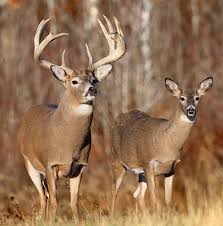Deer hunting is an extremely popular activity for sportsmen and women statewide. In fact, Ohio ranks fifth nationally in resident hunters and 11th in the number of jobs associated with hunting-related industries. Hunting has a more than $853 million economic impact in Ohio through the sale of equipment, fuel, food, lodging and more, according to the National Shooting Sports Foundation’s Hunting in America: An Economic Force for Conservation publication.
Ohi o’s annual youth white-tailed deer hunting season gives young hunters the opportunity to pursue this popular game animal on November 18 and19. It is open to hunters with a youth hunting license and a deer permit.
o’s annual youth white-tailed deer hunting season gives young hunters the opportunity to pursue this popular game animal on November 18 and19. It is open to hunters with a youth hunting license and a deer permit.
During the deer-gun seasons, deer can be hunted with a shotgun, a muzzleloader .38 caliber or larger, a handgun .357 caliber or larger, straight-walled cartridge rifles .357 to .50 caliber, or bows from Monday, November 27, to Sunday, December 3, and December 16 and 17. Details about deer hunting rules are contained in the 2017-2018 Ohio Hunting and Trapping Regulations, available where licenses are sold or at wildohio.gov. Only either-sex permits may be used after Sunday, November 26, unless hunting in an ODNR Division of Wildlife authorized controlled hunt.
Unfortunately, it is this time of the year that many livestock owners begin to fear for the safety of their animals and look for ideas to help. For example, many of the tack shops are selling florescent and reflective halters, causing a dilemma since many livestock owners prefer not to keep halters on their animals when they are turned out. I’ve even heard of a cow owner that felt the only way to keep his animals safe during hunting season was to paint them with fluorescent orange paint. I just can’t imagine having to go to those extremes. That being said, there are a few things to consider as we approach Deer Gun Season if you’re a livestock and/or landowner:
1). Make sure you know who is hunting on you property. All hunters, not related or tenants, need written permission to hunt or pursue game on your property. Hunters are required to have that written permission on their person when hunting.
2). Keep your livestock close. Do you have a paddock that can contain your animals close to the barn?
3). Check your livestock several times throughout the day. Don’t just look at them across the pasture, run your hands over them or at least put your eyes on every part of their body – remember bullets can travel a great distance.
4). Check gates to assure they are properly latched, often. A gate left open is the most common reason for loose livestock. I’ve personally witnessed a horse VS automobile impact – NOT PRETTY!
5). Before the season starts you may want to introduce yourself to the county Game Warden so that he knows who he is dealing with if an issue develops.
Unfortunately there are a few disrespectful hunters that often ruin it for all, even for the conscientious ones. However, a little preparation and diligent care might just be the ticket to keep your land and livestock safe throughout this year’s hunting season.